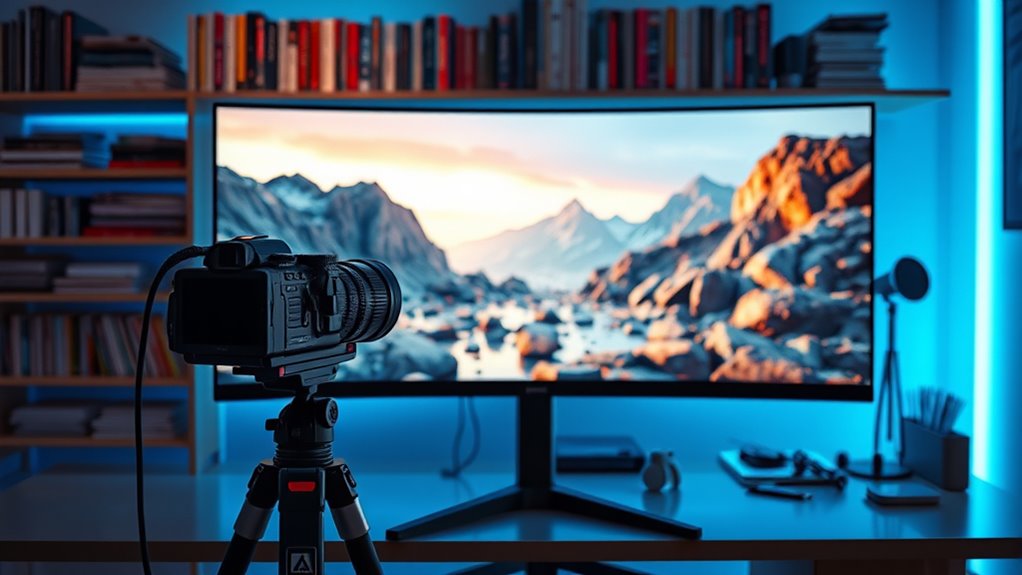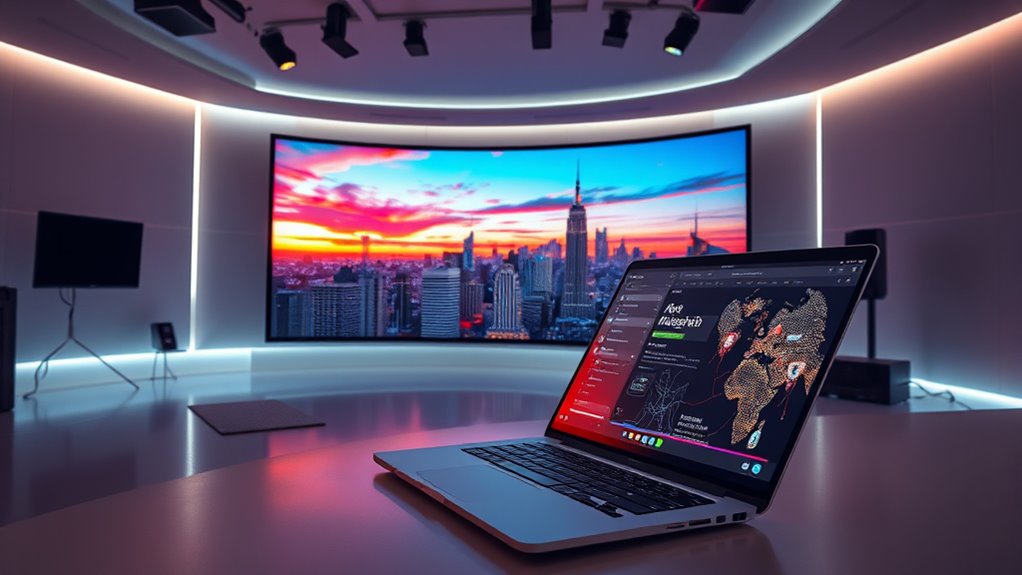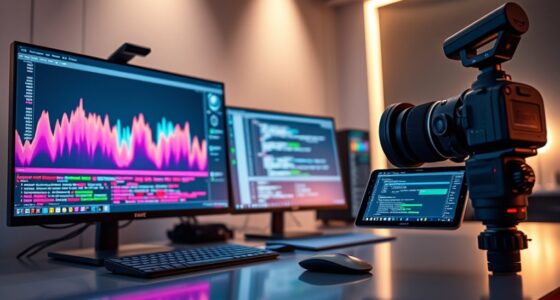Using generative AI helps you quickly create detailed, realistic pre-visualizations of scenes, transforming your ideas into visual sequences that streamline the planning process. It speeds up storyboarding, tests camera angles, and visualizes lighting, all while reducing costs and revision time. This tech also allows collaboration among your team members, ensuring everyone shares the same vision. By incorporating AI in your workflow, you gain better control and efficiency—keep exploring to see how it can elevate your projects further.
Key Takeaways
- AI-generated storyboards enable rapid conversion of ideas into visual scene sequences, streamlining pre-visualization.
- Virtual environment previews allow realistic visualization of scenes with accurate lighting, set design, and camera angles.
- Generative AI fosters collaboration by providing accessible, editable visual outputs for directors, designers, and VFX teams.
- It adapts to various genres and styles, ensuring consistent visual storytelling across diverse project requirements.
- Using AI for pre-visualization reduces costs, shortens timelines, and minimizes costly revisions during production planning.

Pre-visualizing scenes has traditionally been a time-consuming and resource-intensive process, but generative AI is changing that. With AI-generated storyboards, you can quickly turn your ideas into visual sequences that guide your production. Instead of sketching out scenes manually or relying solely on concept artists, AI tools can produce detailed storyboards based on your descriptions, scripts, or shot lists. This not only accelerates the planning phase but also allows for rapid iteration, giving you the freedom to experiment with different camera angles, compositions, and staging without significant delays or costs.
AI-generated storyboards streamline scene planning and enable rapid visual experimentation.
One of the key advantages of AI-generated storyboards is the ability to create virtual environment previews. These previews enable you to visualize how a scene will look within the actual set or location, even before filming begins. By inputting parameters such as lighting conditions, camera positions, and environmental details, you gain a realistic preview of your scene’s atmosphere and spatial relationships. This helps you identify potential issues early, such as spatial constraints or lighting challenges, saving you from costly reshoots or last-minute adjustments during production.
Using generative AI for pre-visualization also streamlines collaboration among your team. Directors, cinematographers, production designers, and VFX artists can all access and modify AI-generated outputs, ensuring everyone stays aligned on the creative vision. The instant feedback loop fosters a more dynamic creative process, where ideas are rapidly tested and refined. Plus, with virtual environment previews, you can present your concepts to stakeholders or clients with a high level of confidence, making it easier to secure approvals and funding.
Another benefit is that AI-driven tools can adapt to different styles and genres, giving you flexibility across projects. Whether you’re working on a sci-fi epic, a period drama, or an animated feature, AI can generate storyboards and environment previews that match your aesthetic requirements. This adaptability reduces the need for multiple specialized artists or extensive manual revisions, cutting down on both time and costs.
In essence, generative AI empowers you to visualize scenes with unprecedented speed and accuracy. It bridges the gap between imagination and realization, enabling you to plan more efficiently and make better-informed decisions before hitting set. By leveraging AI-generated storyboards and virtual environment previews, you streamline your pre-visualization process, ensuring your project stays on schedule and within budget, all while enhancing creative control.
Frequently Asked Questions
What Are the Limitations of Generative AI in Scene Pre-Visualization?
You might think generative AI can perfectly pre-visualize scenes, but it has limitations. It often reflects artificial biases from its training data, which can skew results. Creative limitations also exist, as AI lacks true understanding and intuition, making it hard to generate highly specific or innovative scenes. You’ll find that AI helps with ideas, but it still needs human input to overcome these hurdles for accurate, creative scene pre-visualization.
How Can I Ensure the Generated Scenes Match My Creative Vision?
Ah, the noble quest for perfect creative alignment—surely, a journey worthy of mythic heroes. To guarantee your scenes match your vision, you must wield artistic control like a finely tuned sword. Provide clear, detailed prompts and iteratively refine outputs. Collaborate closely with the AI, giving feedback that steers the results. Remember, the magic lies in your hands—shape the AI’s work to mirror your artistic intent precisely.
What Software Options Are Available for Integrating AI Into Pre-Visualization Workflows?
You want to know about software options for AI integration into pre-visualization workflows. You can explore tools like Unreal Engine, which offers AI-compatible plugins for scene generation, or Blender, with its growing AI add-ons for rapid visualization. Confirm software compatibility by checking the system requirements and plugin support. These options help streamline your workflow, making it easier to create accurate, imaginative scenes aligned with your creative vision.
How Does AI Handle Complex or Highly Detailed Scene Elements?
Imagine AI as a master painter, capturing every brushstroke of your vision. It handles complex, highly detailed scene elements by focusing on scene realism and detail enhancement, adding depth and precision where needed. AI’s algorithms analyze intricate textures, lighting, and structures, seamlessly blending realism with creative nuances. This process guarantees your scenes are rich, believable, and visually compelling—transforming your ideas into vivid, detailed pre-visualizations that truly resonate.
What Are the Ethical Considerations When Using Ai-Generated Scenes?
When you use AI-generated scenes, you should consider ethical issues like privacy concerns and intellectual property. AI may inadvertently reproduce copyrighted material or sensitive data, risking legal trouble. Always guarantee you have rights to the content you generate and respect individuals’ privacy. Being mindful of these factors helps you avoid ethical pitfalls and promotes responsible use of AI technology in creative projects.
Conclusion
By leveraging generative AI to pre-visualize scenes, you can save time and fuel your creativity more efficiently. Did you know that 70% of filmmakers report faster decision-making when using AI-generated visuals? This technology empowers you to experiment and refine ideas before filming, reducing costly re-shoots. Embracing AI in your pre-visualization process not only streamlines production but also unfastens new creative possibilities, helping you bring your vision to life with greater confidence and clarity.









